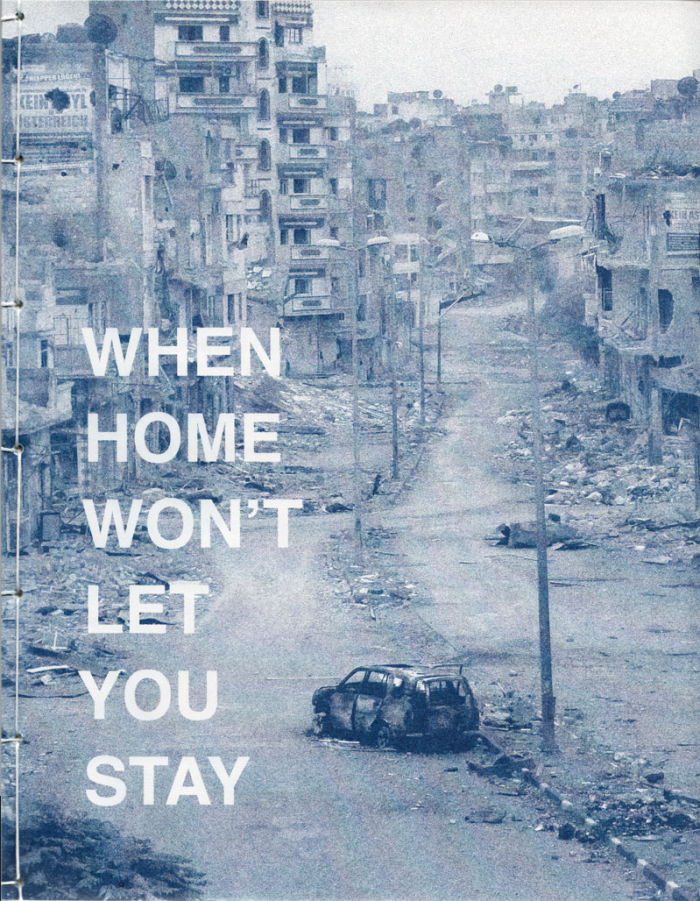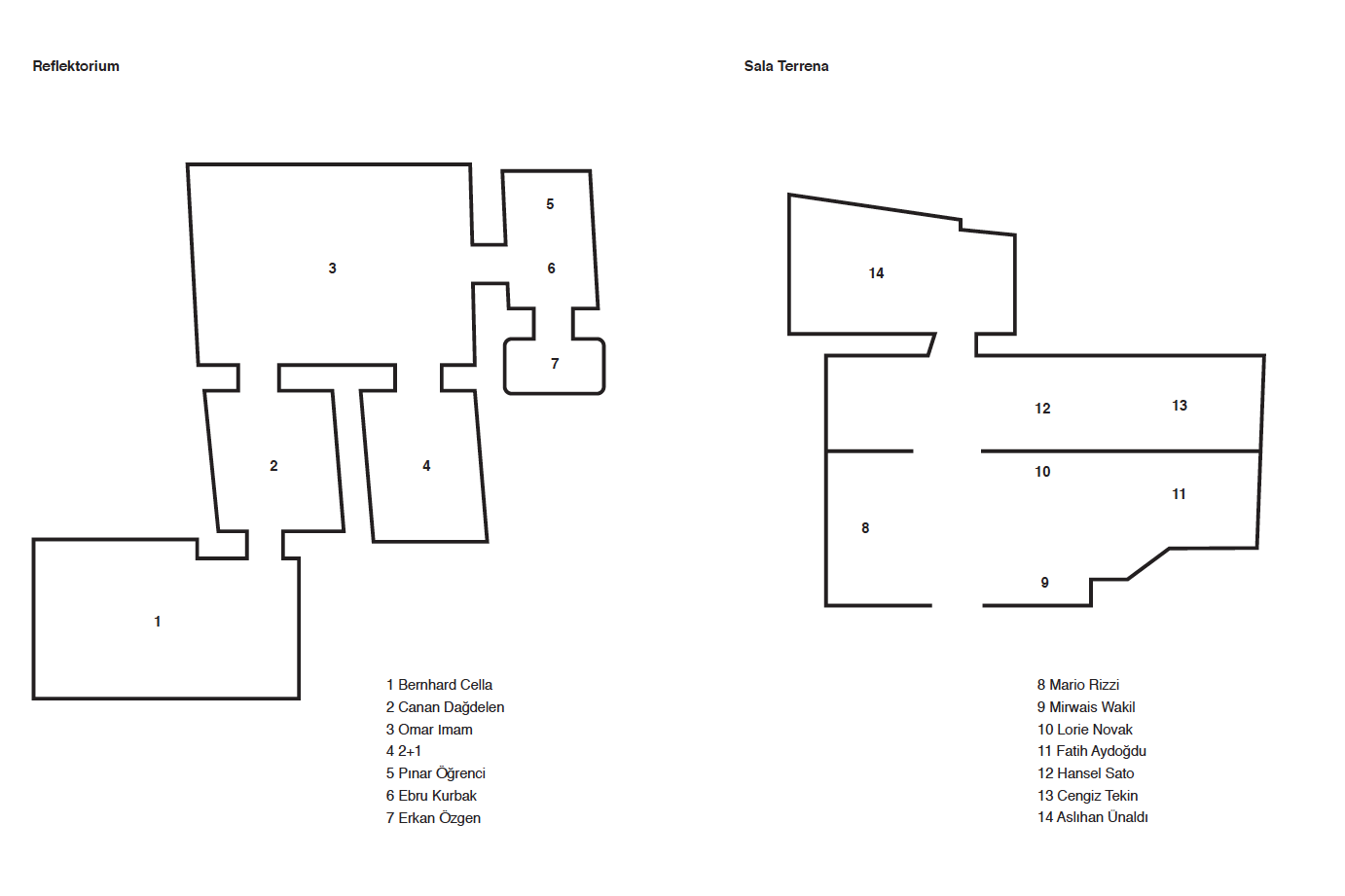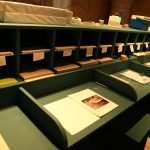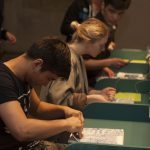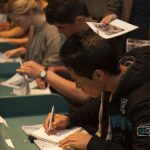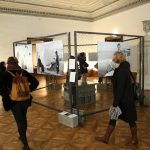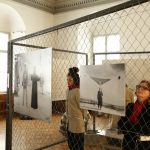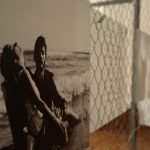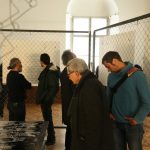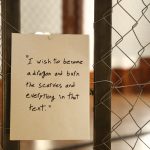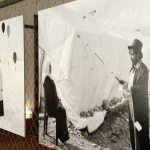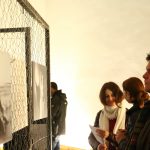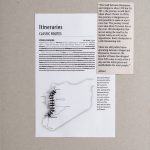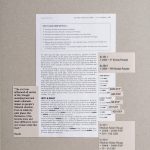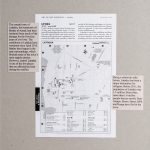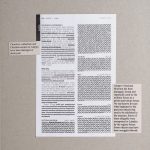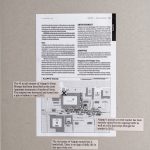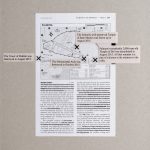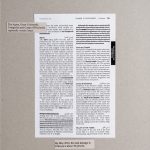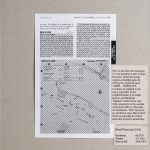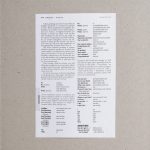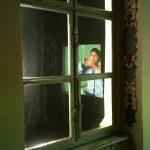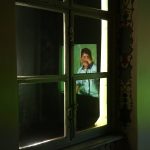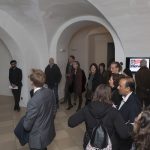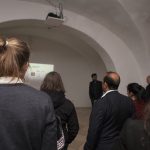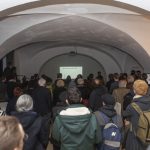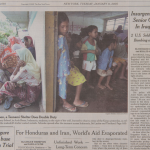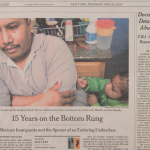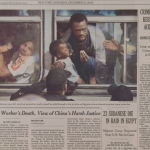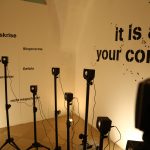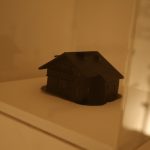when home won’t let you stay
5 – 25 MAY 2016
![]()
Heiligenkreuzer Hof, Schönlaterngasse 5, 1010 Wien
Opening:
4. MAY 2016
(deutscher Text: siehe unten.)
As the twenty-first century unfolds, nationalism is fast losing ground. More and more people believe that all of humankind is the legitimate source of political authority, rather than the members of a particular nationality, and that safeguarding human rights and protecting the interests of the entire human species should be the guiding light of politics. **One day, violence breaks out in a particular region, for reasons hard to grasp. It may be related to religious agitation, or violent capitalism, scarce resources, blood-thirsty war profiteers, injustice in the distribution of land, foreign powers or a traumatic past. There are plenty of possible reasons for people to slaughter one another. And we spectators say, this is not humane. And it really isn’t, although such a breakdown of civility is experienced by humans again and again.
Later, a million desperate journeys start. Thousands of people leave their homes behind, they set off and hit the gruelling road, embarking in a battle of a different kind. They walk, run, jump over fences, remain hungry for too long, carry the weight of their children, some bare necessities, and few personal memorabilia. They carry all that, and carry on with their journey: This requires a lot of courage, strength, and despair. But people do it: People do it when it is about their survival. Have they already arrived to some safe land? By no means, yet the journey has just begun. Unspeakable abuses take place on the way, over and over, and by many different offenders. There is no other hope but to keep running away from the in-humane, the relentless evil that has surrounded the vulnerable ones with its cynical void.
It is not that the bystanders wouldn’t react: They get very well organized on short notice, they help make the journeys happen: Often they charge a lot of money, overfill the lifeboats, abduct people into the unknown. Those who quickly understand the new market learn how to produce fake life jackets – soon to be termed “death jackets” – and cause the drowning of hundreds. The dead have no papers, therefore there is no evidence that they once lived. They had no identities anyone would respect. It is the wild; a boundless arena for any kind of crime.
Some make it to the other shore, while thousands don’t. When you talk to the ones who made it, you often hear that they didn’t succeed in their first attempt. It is not the first boat they climbed into that brought them to the other side, or to the deep water of the sea. It takes many tries, again and again, until they can set foot onto some safe shore. Children disappear, get kidnapped, sent on a diverted route to a nameless fate determined by the skilled agents of human trafficking. Limitless violence, strategic cynicism, profiteering, political gameplay, institutional incompetence, moral courage just as much as hostility; chaos, enforced security, paralyzed as well as berserk states. Emergent solidarity and looming collapse of order; gestures of friendliness, and a terrifying sense of loneliness and exposedness – all of these consequences of human actions impinge onto the walking ones, like an endless beating.
Human beings are great at getting organized, for evil and good: Some indeed feel deeply responsible, hurry to the coasts, assist the ones who made it to the shore, or team up to provide shelter, food, clothing, warmth, and other immediate necessities. The journey, from the beginning until the very end, makes apparent many contradictory facets of being human and humane: countless kinds of human hostility and cruelty as well as empathy, generosity and support to extreme extents. The journey requires not only a lot of courage, but also a lot of hope, and great trust in humanity: That there is a land somewhere that is welcoming and safe, and where a new life can start, at least until there is a chance of return.
But in that land, in a different world, those who have never had to experience a catastrophe (or forgot all too quickly the catastrophes they did experience in recent history) call the arrival of the refugees a ‘crisis’. The inhabitants of the safe land feel under threat: That their identities would get destroyed, that the cost of hospitality would be too high; that their well-developed systems would collapse; that their humaneness would suffer due to the ignorance of the newcomers – a paradox.
Even more so, had human solidarity been stronger, there would be no nightmare about a crisis, but instead the empowering, rejuvenating experience of a collective power to forge our fate. We deprived ourselves of these collective emotions as soon as we put order over empathy, identity control over encounter, and tactical reason of state over strategic humaneness. In fact, it is not only this most recent crisis that the inhabitants of the safer and wealthier lands have failed to transform into an opportunity for reforming and rebuilding the structure and atmosphere of their co-existence. After making it through the outer perimeters of the safe and rich territory, the newcomers will have to experience many forms of institutionalized injustice, social inertia and individual isolation that have been maintained and cemented over generations. It will become apparent to what enormous extent the rich societies, too, are stratified, impenetrable, apathetic, and organised as pyramids of increasing exploitation.
On the 3500-kilometer journey from a now deserted home in Aleppo to Vienna, a Syrian refugee has to witness and endure the state of humanity and humaneness in our time. By trying to perceive the world through the eyes of someone who sets off to seek refuge, an unmasking prospect unfolds – of devastating human experiences, of a catastrophe emerging from an endless chain of atrocities and neglect; but also of support and empathy. The exhibition “when home won’t let you stay” focuses on these astonishingly varied shades of humanity and examines the notion of humaneness in the early 21st century. It interrogates what it means to be human today, in contrast to the ideals of humaneness and human rights. The exhibition asks about the possibilities of socio-economical and political developments towards a more conscious co-existence; not only so as a temporary solution to this immediate catastrophe – the so-called refugee crisis – but also as a confrontation with our individual and communal approaches to being human.
Borrowing its title from a line of the poem Home by Warsan Shire, the exhibition attempts to elucidate the journeys of the displaced between their lost homes and the new ones that will have to be built.
Text by: Işın Önol & Tobias Nöbauer
(deutscher Text: siehe unten.)
* Warsan Shire, Home, poem, 2015
An earlier version of the poem: “Conversations about Home (At the Deportation Centre)”, in Teaching my mother how to give birth, Flipped Eye, London, 2011
** Yuval Noah Harari, Sapiens: A Brief History of Humankind, p.231, Vintage Books, London, 2011
PUBLICATION:
ARTISTS & ARTWORKS AT THE EXHIBITION
Photographs by Saleh Rozati and Omar Imam ©Angewandte
Listed according to the numbers shown at the exhibition plan below:
Bernhard Cella
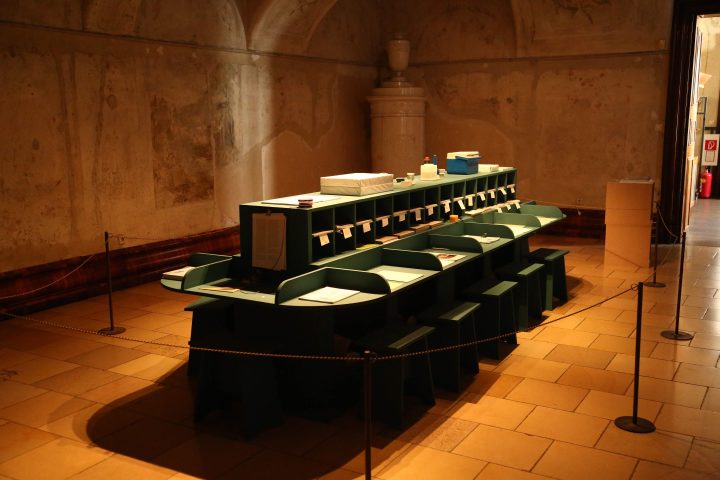
Bernhard Cella, Das unsichtbare Handwerk / The Invisible Craft, 2016 Installation, Dimensionen variabel / dimensions variable
As part of his publication concept for “When home won’t let you stay” Bernhard Cella displays the medium’s invisible labour process in the exhibition space: Within the framework of his contribution “The Invisible Craft” the individual book chapters, which primarily consist of contributions by the artists who participate in the exhibition, are collated, blocked, and bound at a workbench constructed for the production. The work of each producer of a thread binding is personalized through annotation and signature. As the element that connects the different contents of the book, the form of the thread itself becomes content. (Excerpt from the catalogue text by Leo Findeisen)
Als Teil seines Publikations-Konzept für „When home won’t let you stay“ bringt Berhard Cella den unsichtbaren Arbeitsschritt des Mediums in den Ausstellungsraum: In seinem Beitrag „Das unsichtbare Handwerk“ werden an einer für die Produktion konstruierten Werkbank die einzelnen Kapitel, die hauptsächlich Beiträge von den Künstlerinnen und Künstlern der Ausstellung enthalten, in Handarbeit kollationiert, geblockt und gebunden. Die Arbeit der jeweiligen am Bindungsprozess Beteiligten wird durch Vermerk und Unterschrift personalisiert. Als verbindendes Element der verschiedenen Buchinhalte wird die Bindung selbst zum Inhalt. (Exzerpt aus dem Katalogtext von Leo Findeisen)
Bernhard Cella, Das unsichtbare Handwerk / The Invisible Craft, 2016 Installation, Dimensionen variabel / dimensions variable
Bernhard Cella lives in Vienna. He studied at the Academy of Fine Arts Vienna, at the University of Fine Arts of Hamburg, and at the University of Arts and Industrial Design Linz (stage design and free art). His latest projects include “Avant La Lettre”, large-scale tapestry, Salzburg city library, Salzburg (2015); “ich will wissen wie ihr wohnt”, installation and process, Kunstverein Hamburg (2014); “Schleusen”, installation, Kiesler foundation, Vienna (2014); “9742”, installation, Academy of Fine Arts Vienna (2013); “Let the Artist sign your book”, installation and performance, 21er Haus, Vienna (2012).
Bernhard Cella lebt in Wien. Er studierte an der Akademie der Bildenden Künste Wien, der Hochschule für Bildende Künste Hamburg und an der Kunstuniversität Linz (Bühnenbild und freie Kunst). Zu seinen letzten Projekten zählen „Avant La Lettre”, Großraumgobelin, Stadtbibliothek, Salzburg (2015); „ich will wissen wie ihr wohnt”, Installation und Prozess, Kunstverein Hamburg (2014); „Schleusen”, Installation, Kiesler Privatstiftung, Wien (2014); „9742”, Akademie der bildenden Künste Wien (2013); „Let the Artist sign your book”, Installation und Performance, 21erHaus, Wien (2012).
Canan Dağdelen
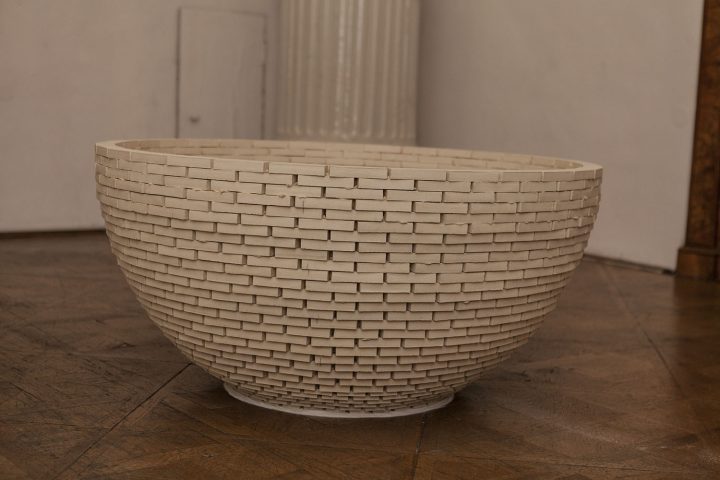
Canan Dağdelen, Upturn, 2001 Weißer Ton, Steinkleber, Sand / White clay, stone glue, sand 120 Ø x 56 cm Courtesy EKWC, NL
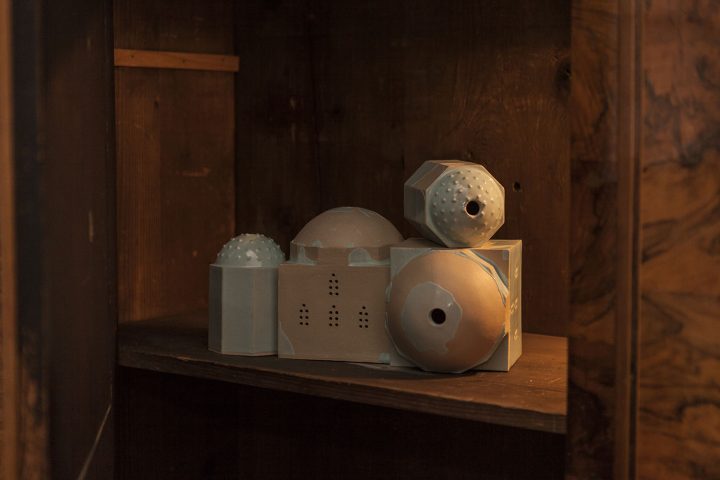
Canan Dağdelen, So Close So Far Away, 2015 Weißer Ton, Glasur / White clay, glaze 24 x 28 x 24 cm
Canan Dağdelen, with her sculptural work presented at the exhibition, attempts at reversing the robust impression of architectural constructions and their meanings. Dealing with the notion of displacement, Dağdelen creates an imaginary form of home, that is not merely left behind, but partially carried within, and that seeks possibilities to be re-constructed.
Canan Dağdelen versucht mit ihren in der Ausstellung präsentierten skulpturalen Arbeiten die starren Eindrücke von architektonischen Konstruktionen und ihre Bedeutungen umzukehren. In der Auseinandersetzung mit der Idee von Vertreibung, erschafft Dağdelen eine imaginäre Form von Heimat, die nicht nur zurückgelassen, sondern auch teilweise mitgeführt wird, und nach Möglichkeiten sucht wieder-aufgebaut zu werden.
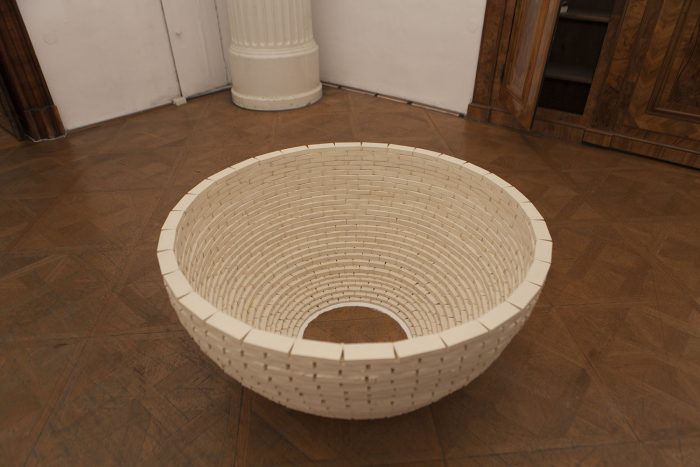
Canan Dağdelen, Upturn, 2001 Weißer Ton, Steinkleber, Sand / White clay, stone glue, sand 120 Ø x 56 cm Courtesy EKWC, NL
Canan Dağdelen graduated from the Vienna University of Business and Economics and from the University of Applied Arts Vienna. She lives and works in Vienna, where she is also a lecturer in art education at the Department for Design, Architecture and Environment at the University of Applied Arts. Her works are presented internationally.
Canan Dağdelen absolvierte die Wirtschaftsuniversität Wien und die Hochschule für angewandte Kunst Wien. Sie lebt und arbeitet in Wien, auch als Dozentin an der Universität für angewandte Kunst Wien in der Abteilung DAE/Design, Architektur und Environment für Kunstpädagogik. Ihre Arbeit wird international gezeigt.
Omar Imam

Omar Imam, live, love, refugee, 2014–ongoing Photo-Installation Dimensionen variabel / dimensions variable
With the photo-series “live, love, refugee” presented as the heart of a spacious installation, Omar Imam approaches the mental state of Syrian refugees, asking how relationships and dreams are affected by conflict and displacement. In multi-layered photographs, using elements referring to symbolism and surrealistic narratives he portraits the complex psychological situation of his protagonists. Taken in Lebanon and now displayed on high fences, the photographs are a visual evocation of the pain and desire of people who struggle to survive in their new land.
Kernstück von Omar Imams raumgreifender Installation ist die Fotoserie „live, love, refugee”, mit der der Künstler sich dem mentalen Zustand syrischer Flüchtlinge annähert und Fragen nach den Auswirkungen von Konflikt und Entwurzelung auf deren Beziehungen und Träume stellt. In mehrschichtige Fotografien porträtiert er durch den Gebrauch symbolistischer Stilmittel und surrealistischer Narrative die komplexe psychologische Situation seiner Protagonistinnen und Protagonisten. Die im Libanon aufgenommenen und hier an Zaun-Elementen präsentierten Bilder sind eine visuelle Beschwörung des Schmerzes und der Sehnsucht von Menschen, die in ihrem neuen Land ums Überleben kämpfen.
Omar Imam is a Beirut-based, Syrian photographer and filmmaker who often has to publish his work under a pseudonym. In his photographic works, Imam uses irony and a conceptual approach to respond to the violent situation in Syria. After leaving Damascus in late 2012, he began making fictional short films that often focus on the Syrian refugee experience. Individually and with NGOs, he has produced films, photography projects, and workshops for Syrian refugees in Lebanon.
Omar Imam ist ein syrischer Fotograf und Filmemacher, er lebt in Beirut und muss häufig seine Arbeit unter einem Pseudonym publizieren. In seinen fotografischen Arbeiten nutzt er Ironie und einen konzeptionellen Ansatz um auf die brutale Situation in Syrien zu antworten. Nachdem er Damaskus Ende 2012 verlassen hatte, begann er fiktive Kurzfilme zu produzieren, die sich häufig auf die Erfahrung von Flucht dreht. Allein und in Zusammenarbeit mit NGOs hat er Filme, Fotoprojekte und Workshops für syrische Flüchtlinge im Libanon verwirklicht.
2+1 (Selda Asal & Özgür Erkök Moroder)

2+1 (Selda Asal & Özgür Erkök Moroder), Goodbye My Home, 2016 Video
“Goodbye My Home” is a rap music project that targets displaced teenagers, to open up a space for forms of expression through artistic processes. The video has been realised with young inhabitants of the refugee centre Vordere Zollamstraße in Vienna. In close collaboration with the artists Selda Asal and Özgür Erkök Moroder personal stories got transformed into lyrics, recorded as a rap song and performed for a music video.„
Goodbye My Home“ ist ein Rap-Musik-Projekt, das sich an geflüchtete Jugendliche zwischen 15 und 22 Jahren wendet um Räume für verschiedene Formen es Selbstausdruckes durch künstlerische Prozesse zu öffnen. Das Video wurde mit jungen Bewohnerinnen und Bewohnern der Flüchtlingsunterkunft Vordere Zollamtstraße entwickelt. In enger Zusammenarbeit mit der Künstlerin Selda Asal und dem Künstler Özgür Erkök Moroder wurden aus persönlichen Geschichten Texte verfasst, als Rap-Songs aufgenommen und für ein Musikvideo performt.
2+1 is one of the sub-groups of Apartment Project, one of the first artist-run spaces in Istanbul. Established in 1999 by Selda Asal, Apartment Project aimed at interdisciplinary sharing, communion work and process-oriented production. Since 2012 the Berlin and Istanbul based artist Selda Asal, has been continuing these practices and collective production models at Apartment Project Berlin. Özgür Erkök Moroder is a multidisciplinary artist, Apartment Project Berlin’s performance and events coordinator and member of the art collective “Ha Za Vu Zu” in Istanbul.
2+1 ist eine der Untergruppen von Apartment Project, einem der ersten von Künstlerinnen und Künstlern betriebenen Räume Istanbuls. Apartment Project wurde im Jahr 1999 von Selda Asal mit dem Ziel gegründet, interdisziplinären Austausch, Gemeindearbeit und prozessorientierte Produktion zu fördern. Seit 2012 führt die in Berlin und Istanbul tätige Künstlerin Selda Asal diese Praktiken und Modelle kollektiver Produktion im Rahmen von Apartment Project Berlin fort. Özgür Erkök Moroder ist Performance- und Eventkoordinator von Apartment Project Berlin und Mitglied des Kunstkollektivs „Ha Za Vu Zu” in Istanbul.
Pınar Öğrenci

Pınar Öğrenci, Mawtini, 2016 Video, 7’47”
Mawtini (My homeland) is a popular poem written by the Palestinian poet Ibrahim Tuqan in 1934. With original music composed by Muhammad Fuliefil it has since then been the national anthem of Palestine and since 2004 upon the order of the temporary coalition government also of Iraq. Pınar Öğrenci’s video is a collection of performances of Mawtini from Algeria, Palestine, Iraq and Syria in various forms, either as an anthem or as pop-songs on YouTube. It is a display of the diversity surrounding a national anthem: from army choirs to pop-singers, from simple home-recordings to street performances, from television shows to concerts. “Mawtini” points out the differences in perceptions of the concepts of nation, national anthem, and homeland in the world where the song is originated, from those of the West.
Mawtini (Mein Heimatland) ist ein 1934 verfasstes Gedicht des palästinensischen Dichters Ibrahim Tuqan. Mit einer Komposition von Muhammad Fuliefil wurde es zur Nationalhymne von Palästina und 2004 auf Anordnung der temporären Koalitionsregierung auch des Irak. Pınar Öğrencis Video zeigt eine Sammlung von verschiedensten in Algerien, Palästina, dem Irak und Syrien aufgezeichneten Darbietungen dieses Liedes – sei es in Form einer Hymne oder eines Pop-Songs auf YouTube. Es führt die Diversität vor, die eine Nationalhymne umgibt: von Militärchören und Popstars, zu einfachen Heimvideos und Straßenperformances, Fernsehshows und Konzerten. „Mawtini“ verweist darauf, wie sich die Wahrnehmung von Begriffen wie Nation, Hymne und Heimat in der Welt aus der Mawtini stammt, von jener des Westens unterscheiden.
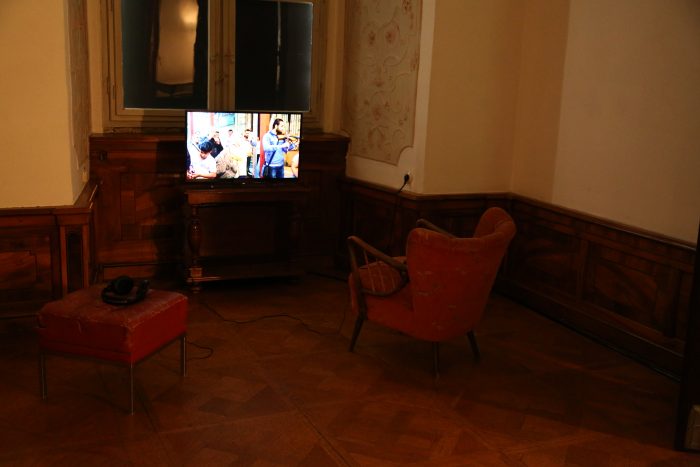
Pınar Öğrenci (b. 1973 in Van, Turkey) is a visual artist, writer and curator based in Istanbul. Öğrenci studied architecture and received her master’s degree in architectural restoration from Yildiz Technical University, Istanbul. In her artistic practice, Öğrenci uses various media, including photography, video, performance, and installation, to explore how architecture, city and technology are perceived through body, space and memory. The artist also works on subjects with an autobiographical quality, where she inquires into how conflicts, collective celebrations, stories of heroism and history writing are instrumentalized as tools for cultural assimilation policies.
Pınar Ögrenci (geb. 1973, Van, Türkei) ist bildende Künstlerin, Schriftstellerin und Kuratorin, sie lebt in Istanbul. Öğrenci studierte Architektur und erwarb 1998 einen Master in Architekturrestaurierung an der technischen Universität Yıldız, İstanbul. In ihrer künstlerischen Praxis verwendet Öğrenci unterschiedliche Medien, unter anderem Fotografie, Video, Performance und Installation, um zu untersuchen, wie Architektur, die Stadt und Technologie durch Körper, Raum und Erinnerung wahrgenommen werden. Die Künstlerin arbeitet auch zu Themen mit autobiografischen Zügen, in denen sie hinterfragt, wie Konflikte, gemeinsames Feiern, Heldenerzählungen und Geschichtsschreibung als Werkzeuge kultureller Assimiliationspolitik instrumentalisiert werden.
Ebru Kurbak

Ebru Kurbak, Lonely Planet, 2016 Installation Dimensionen variabel / dimensions variable
Within the period of only five years Syria turned from an exotic tourist destination to one of the most dangerous places on the planet: From the land of camels, lanterns, spices and 2000-year-old ancient city, to a warzone. With her project “Lonely Planet” Ebru Kurbak juxtaposes the former highlights of the travel guide with the country’s present-day reality through memories and personal stories of people who fled from there.
Im Zeitraum von nur fünf Jahren wurde Syrien von einer exotischen Touristendestination zu einem der gefährlichsten Orte unseres Planeten. Vom Land der Kamele, Laternen, Gewürze, 2000 Jahre alter Städte und antiken Ruinen, zum absoluten Kriegsgebiet. Mit Hilfe der Erinnerungen und persönlichen Geschichten von dort Geflohener stellt Ebru Kurbak in ihrer Arbeit „Lonely Planet“ die einstigen Highlights im Reiseführer mit der heutigen Realität des Landes gegenüber.
Images by © kollektiv fischka/kramar
Ebru Kurbak is an artist, designer and educator based in Vienna. She currently runs the collaborative artistic research project “Stitching Worlds” at the University of Applied Arts in Vienna. In her artistic work, Ebru Kurbak is driven by her interest in the hidden political nature of everyday spaces, technologies and routines. Through creating objects, installations and participatory situations, she critically probes how the design of the ordinary is involved in shaping individual and societal values, practices and ideologies. Ebru received her Masters in Architecture from Istanbul Technical University, lectured at the Departments of Visual Communication Design and Photography and Video at the Istanbul Bilgi University and the Department of Space & Design Strategies at the University of Arts and Industrial Design in Linz.
Ebru Kurbak lebt als Künstlerin, Designerin und Pädagogin in Wien. Sie leitet derzeit das kooperative künstlerische Forschungsprojekt „Stitching Worlds” an der Universität für Angewandte Kunst Wien. In ihrer künstlerischen Arbeit wird Ebru von ihrem Interesse am versteckten politischen Wesen alltäglicher Räume, Technologien und Abläufe geleitet. Indem sie Objekte, Installationen und partizipative Situationen herstellt, erprobt sie kritisch, wie die Gestaltung des Gewohnten dazu beiträgt, individuelle und gesellschaftliche Werte, Praktiken und Ideologien zu formen. Ebru erwarb einen Master in Architektur an der Technischen Universität Istanbul. Sie war Vortragende an den Instituten für Visuelle Kommunikation, Design und Fotografie, sowie für Design, Fotografie und Video an der Bilgi Universität Istanbul und am Institut für Raum und Designstrategien der Kunstuniversität Linz.
Erkan Özgen

Erkan Özgen, Wonderland, 2016 Video, 4’
Erkan Özgen’s “Wonderland” is the outcome of his special encounter with a deaf and mute boy at the age of 13. While bringing support for the families who ran away from the IS attacks in Kobani and took shelter at Derik, a small Kurdish town in Turkey the artist met Mohammed who was able to transmit the devastating experience that he and his family had to go through, very accurately and powerfully, despite the lack of his oral competences. Through Özgen’s unassertive camera view, Mohammed silently yet intensively conveys the occurrence of inconceivable violence.
Erkan Özgens „Wonderland“ ist das Ergebnis einer besonderen Begegnung mit einem taubstummen 13-Jährigen: Der Künstler traf auf Mohammed als er den Familien, die auf der Flucht vor den IS-Attacken auf Kobani in Derik, einer kleinen kurdischen Stadt in der Türkei, Unterschlupf suchten, Hilfsgüter brachte. Der Junge war trotz seines Unvermögens sich mündlich auszudrücken in der Lage die schrecklichen Erfahrungen, die seine Familie erleiden mussten, sehr detailliert und eindringlich zu vermitteln. Durch den verhaltenen Blick von Özgens Kamera überliefert Mohammed still aber umso intensiver Szenen unvorstellbarer Gewalt.
Erkan Özgen was born in Derik in Mardin province, Turkey in 1971 and graduated from the Department of Art Education at Cukurova University in 2000. His artistic adventure began in 1998 with a contemporary art exhibition “Young Activities”. Since that time he has participated in numerous international group exhibitions. In 2005, Özgen participated in a residency program in the International Artists’ Studio Program in Sweden (IASPIS) and received the Prix Meuly from the Kunstmuseum Thun, Switzerland. In 2008, he took part in the Can Xalant artist exchange program at the Centre for Creating and Contemporary Thought in Mataró, Barcelona. He has also organised workshops in Beirut, Damascus, Diyarbakir and Enshede.
Erkan Özgen wurde 1971 in Derik in der türkischen Provinz Mardin geboren und schloss im Jahr 2000 sein Studium am Institut für Kunsterziehung der Universität Cukurova ab. Sein künstlerisches Abenteuer begann 1998 mit einer Ausstellung zeitgenössischer Kunst unter dem Titel „Young Activities“. Seither nahm er an zahlreichen internationalen Gruppenausstellungen teil. 2005 absolvierte Özgen das Residenzprogramm des International Artists Studio Program Malmö in Schweden (IASPIS) und erhielt er den „Prix Meuly” des Kunstmuseum Thun, Schweiz. Im Jahr 2008 nahm er am Künstleraustauschprogramm Can Xalant am Centre for Creating and Contemporary Thought in Mataró, Barcelona teil. Er organisierte Workshops in Beirut, Damaskus, Diyarbakir und Enshede.
Mario Rizzi

Mario Rizzi, Al Intithar, 2013 Video, 30’ Courtesy Mario Rizzi & Sharjah Art Foundation
The protagonist of “Al Intithar” is a widow from Homs whose husband was killed in an attack by the Syrian army. Director Mario Rizzi followed her life at the refugee camp Zaatari for seven weeks. Zaatari is located seven kilometres to the south of the Syrian border in the Jordanian desert and houses 45,000 refugees and still 10,000 more arrive every week. This film is the first part of a trilogy about the emergence of a new civil consciousness in Malaysia, Tunisia, Egypt, Bahrain and Syria, which also looks at the social implications of the end of post-colonialism in these countries.
In Al Intithar begeleitet der Regisseur Mario Rizzi eine Witwe aus Homs, deren Mann bei einem Angriff der syrischen Armee getötet wurde, sieben Wochen lang durch ihren Alltag im Flüchtlings-Camp Zaatari. Sieben Kilometer südlich der syrischen Grenze in der jordanischen Wüste gelegen beherbergt das Camp bereits 45.000 Menschen, wöchentlich treffen etwa 10.000 zusätzliche Menschen auf der Flucht dort ein. Der Film ist der erste Teil einer Trilogie, die ihr Augenmerk auf das Aufkommen eines neuen Zivilbewusstseins in Malaysia, Tunesien, Ägypten, Bahrain und Syrien legt und gleichzeitig die sozialen Implikationen im Fokus hat, die das Ende des Postkolonialismus in diesen Ländern bedeutet.
Mario Rizzi (b. 1962, Italy) is an artist and filmmaker. His films explore the relationship between privacy and civil engagement and reflect on the problematics of representation. He exhibited at Badischer Kunstverein, Karlsruhe; Ankara Film Festival; Pinacoteca Nazionale Bologna; MAXXI Museum, Rome; MoMA PS1, New York; Neuer Berliner Kunstverein, Berlin; Austrian Museum of Applied Arts/Contemporary Art, Vienna; International Architecture Biennale, Venice; SALT Beyoglu, Istanbul; Van Abbemuseum, Eindhoven; Taipei Biennial; Göteborg Biennial; Istanbul Biennial and Sydney Biennial. His films were selected twice for Berlin Film Festival (2013 & 2008). In 2005 Rizzi won the Best Artist Prize of 7th Sharjah Biennial.
Mario Rizzi (geb. 1962, Italien) ist Künstler und Filmemacher. Seine Filme untersuchen das Verhältnis von Privatsphäre und zivilem Engagement und reflektieren über Probleme der Repräsentation. Er stellte unter anderem bei folgenden Institutionen und Events aus: Badischer Kunstverein, Karlsruhe; Ankara Film Festival; Pinacoteca Nazionale, Bologna; MAXXI Museum, Rom; MoMA PS1, New York; Neuer Berliner Kunstverein, Berlin; Österreichisches Museum für angewandte Kunst/Gegenwartskunst, Wien; Internationale Architekturbiennale Venedig; SALT Beyoğlu, Istanbul; Van Abbemuseum, Eindhoven; Taipei Biennale; Göteborg Biennale; Istanbul Biennale und Sydney Bienniale (2004). Seine Filme wurden zweimal für das Filmfestival Berlin nominiert (2008 und 2013). Im Jahr 2005 gewann Rizzi den “Best Artist Prize” der 7. Sharjah Biennale.
Mirwais Wakil
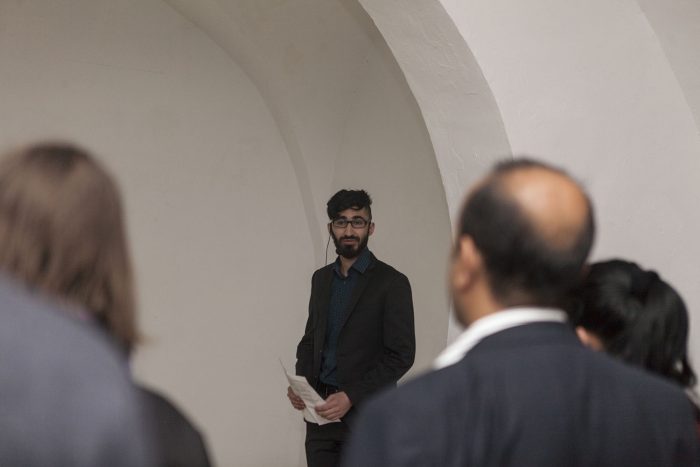
Mirwais Wakil, Integration, how? Lecture Performance / Video, 20’
Mirwais Wakil takes into account the notion of integration by examining the issue through personal and professional experiences over the last decade. To him, integration is directly related to political science and economics, fields he has studied and worked within. He focuses on the economic implications in regards to the newly arrived refugees, not only questioning the role of the government but also possible contributions of individuals for a better tomorrow.
Mirwais Wakil beleuchtet die Idee von Integration in Hinblick auf seine persönlichen und professionellen Erfahrungen mit dem Thema über die letzten zehn Jahre. Für ihn steht Integration in direktem Zusammenhang mit Politikwissenschaft und Wirtschaft – zwei Disziplinen die er studiert beruflich kennengelernt hat. Er konzentriert sich auf ökonomische Konsequenzen im Bezug auf die neu ankommenden Geflüchteten und befragt nicht nur die Rolle der Regierung sondern auch mögliche Beiträge Einzelner zu einer besseren Zukunft.
Mirwais Wakil holds a bachelor’s degree in political science, economics, and studio art from St. Olaf College. He is a recipient of a Rotary International Scholarship and will use it to pursue a master’s degree in the department of International Relations at the London School of Economics. Mirwais received many awards and scholarships including Shelby Davis scholarship, Magnus the good award, and novel peace prize forum scholarship. He had co-founded “ready power”, an organisation that employed people with refugee background aiming to help them quickly integrate into the Austrian society.
Mirwais Wakil schloss Studien in Politikwissenschaft, Wirtschaft und Studio Art am St. Olaf College ab. Er ist Stipendiat von Rotary International am Institut für Internationale Beziehungen der London School of Economics. Mirwais erhielt eine Vielzahl von Auszeichnungen und Stipendien, unter anderem das Shelby Davis Stipendium, den Magnus the Good Preis, und ein Stipendium des Nobel Peace Prize Forum. Er ist Mitbegründer von „Ready Power“, einer Organisation, die Menschen mit Flüchtlingshintergrund anstellte, um ihnen dabei zu helfen sich rasch in die österreichische Gesellschaft zu integrieren.
Lorie Novak
 |
 |
| Above The Fold: Refugees and Migrants, 2000–2015, Installation Dimensions variable |
Animated statistics showing the New York Times Newspaper covering the refugees and migrants on its front cover between 2000 and 2015. |
With “Above The Fold” Lorie Novak explores through a personal “newspaper archive” how images construct the news and make history. Collecting the New York Times since the year 2000, the artist categorises the newspapers and the recurring image tropes of the front-page according to the subject above the fold: men with guns, people holding photos, dead bodies, people grieving, memorials, protest, war and conflict, refugees and migrants, weather, natural disasters, sports, U.S. presidents, and politicians posing for photo ops or campaigning. While over the years, the relative size of the categories changes, trends emerge and boundaries break, currently “U.S. Presidents” and “Men & A Few Women with Guns” are the most common themes.
Mit einem persönlichen „Zeitungs-Archiv” erkundet Lorie Novak in „Above the Fold“ wie Bilder Nachrichten konstruieren und Geschichte schreiben. Die Künstlerin, die im Jahr 2000 begann die New York Times zu sammeln, kategorisiert die Zeitungen und die wiederkehrenden Bildtropen der Titelbilder nach dem Sujet oberhalb des Knicks: Männer mit Gewehren, Menschen, die Fotografien hochhalten, Leichen, trauernde Menschen, Denkmäler, Protestmärsche, Krieg und Konflikt, Flüchtlinge und Migranten, Wetter, Naturkatastrophen, Sport, US-Präsidenten sowie Politiker, die für Fotos posieren und Wahlkampf betreiben. Während sich über die Jahre die Größe der Kategorien ändert, Trends auftauchen und Grenzen verschwimmen, sind derzeit die beiden häufigsten Motive „US-Präsidenten“ und „Männer und ein paar Frauen mit Gewehren”.
Lorie Novak is an artist and Professor of Photography and Imaging at New York University’s Tisch School of the Arts and Associate Faculty at the Hemispheric Institute of Performance and Politics. She uses various technologies of representation to explore issues of memory and transmission, identity and loss, presence and absence, shifting cultural meanings of photographs, and the relationship between the intimate and the public. Her ongoing web project collectedvisions.net, founded in 1996, explores how family photographs shape our memory was one of the earliest interactive storytelling sites. Novak received her MFA from The School of the Art Institute of Chicago and BA from Stanford University. She lives in Brooklyn, New York.
Lorie Novak ist Künstlerin und Professorin für Fotografie und Bildgebung an der Tisch School of Arts der New York University, sowie assoziiertes Fakultätsmitglied des Hemispheric Institute of Performance and Politics. Sie nutzt unterschiedlichste Techniken der Repräsentation um Fragen des Gedächtnisses und seiner Übermittlung, Identität und Verlust, Präsenz und Absenz, den Wandel der kulturellen Bedeutung von Fotografie sowie die Beziehung zwischen dem Privaten und dem Öffentlichen zu untersuchen. Ihr 1996 gegründetes Online-Projekt collectedvisions.net untersucht, wie Familienfotografien unsere Erinnerung formen. Es war eine der ersten interaktiven, dem Storytelling gewidmeten Seiten. Novak erwarb ihren MFA an der School of the Art Institute of Chicago und einen BA der Stanford University. Sie lebt in Brooklyn, New York.
Fatih Aydoğdu
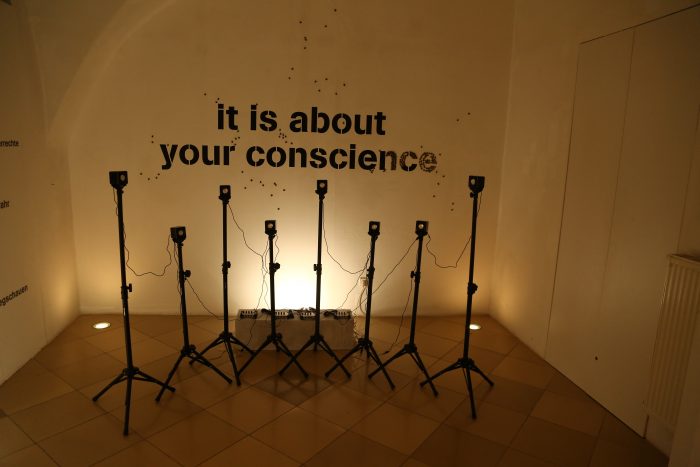
Fatih Aydoğdu, State of Anxiety, 2016 Installation Dimensionen variabel / dimensions variable
The work focuses on the politicians’ use of language related to the refugee issue and on the arrays of meaning behind it. It attempts at re-enacting the overwhelming environment for the conscience to deal with the cacophony created by the media based on threat, deterrence, and anxiety that is spread by such language consisting of subtle messages and stereotypes.
Die Arbeit beschäftigt sich mit dem spezifischen Sprachgebrauch von Politikerinnen und Politikern im Kontext der Flüchtlings-Frage und den dahinterliegenden Bedeutungsfeldern. Sie versucht jene überwältigende Umgebung nachzuzeichnen, der unser Bewusstsein ausgesetzt ist, wenn es versucht, mit der von den Medien hervorgebrachten Kakophonie umzugehen – einer Kakophonie die auf Drohszenarien, Abschreckung und Angst basiert, die durch diese Art von Sprache über subtile Botschaften und Stereotypen verbreitet wird.
Fatih Aydoğdu (b. 1963 in Turkey) lives and works in Vienna and Istanbul. He studied at the Academy of Fine Arts in Istanbul and graduated from the Academy of Fine Arts Vienna. Aydoğdu is a conceptual visual artist, designer, curator and sound artist, focusing on concepts of media aesthetics, migration and politics of identity and linguistic issues. He took part in numerous exhibitions throughout Europe, Asia and USA. He published the first Turkish Media-Art and Theory Magazine “hat” in 1998 in Istanbul. Aydoğdu is a member of the Curatorial Board of Amber Platform Istanbul.
Fatih Aydoğdu (geb. 1963, Türkei) lebt und arbeitet in Wien und Istanbul. Er studierte an der Akademie der bildenden Künste Istanbul und schloss ein Studium an der Akademie der bildenden Künste Wien ab. Aydoğdu ist Konzeptkünstler, Designer, Kurator und Soundkünstler, seine Schwerpunkte liegen auf Konzepten der Medienästhetik, Migration und Identitätspolitik sowie linguistischen Fragen. Er nahm an zahlreichen Ausstellungen in Europa, Asien und den USA teil. 1998 gab er in Istanbul das erste türkische Magazin zu Medienkunst und Theorie mit dem Titel „hat“ heraus. Aydoğdu ist Mitglied des Kuratoriums von Amber Platform in Istanbul.
Hansel Sato
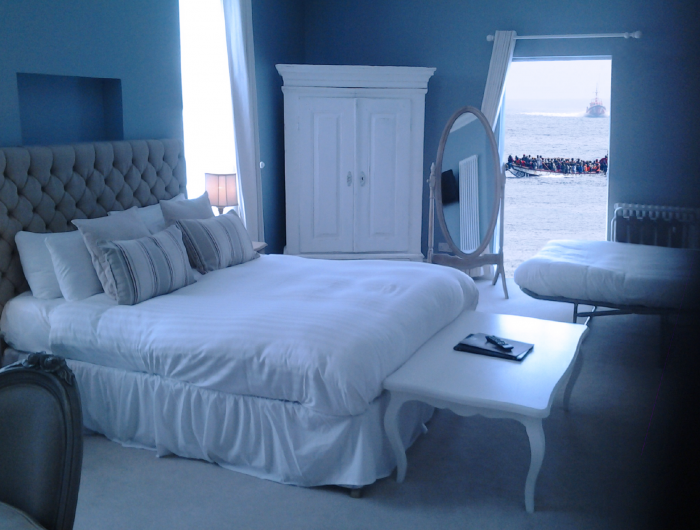
Hansel Sato, Family, love, home, 2016 Photo-collage 35,5 x 53 cm; 41,5 x 44 cm; 56,5 x 50,5 cm
“Family, love, home” by Hansel Sato, deals with the representation of the refugee crisis from the European perspective. He interrogates the ways in which this crisis re-shaping our relationships and our idea of home and questions: To what extent the stranger “outside” is a projection of the stranger in ourselves? Using IKEA objects (which have become symbols of the -decaying- European middle class), texts and photomontages, he conceptualises the collective reaction of estrangement and fear in the face of this historical moment in Europe.
„Family, love, home“ von Hansel Sato verhandelt die Darstellung der Flüchtlingskrise aus Europäischer Perspektive. Er untersucht die Wege in denen diese Krise unsere Beziehungen und unsere Idee von Heimat neu formt und stellt die Frage: In wie weit ist das Fremde „außerhalb“ ein Schutz für das Fremde in uns selbst? Durch den Gebrauch von IKEA Objekten (die zu Symbolen der sich im Verfall befindenden Europäischen Mittelklasse geworden sind), Texten und Fotomontagen konzeptualisiert er die kollektive Reaktion auf Entfremdung und Angst im Angesicht dieses historischen Moments in Europa.
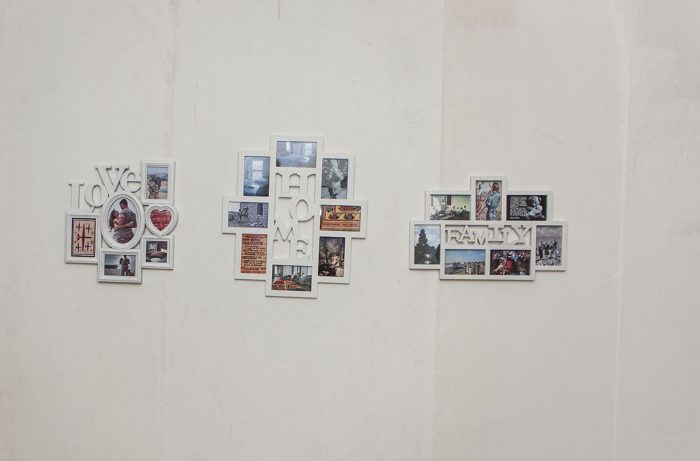
Hansel Sato was born in in Trujillo, Peru. He came to Vienna in 1998 with the Unesco-Aschberg grant for art and since then he has been living and working there. He studied painting and graphics at the Academy of Fine Arts Vienna with Prof. Franz Graf. Before that he was Assistant at the Universidad Católica de Lima. He has represented his country at several biennials and international events. His artistic work includes figurative painting, comic, drawing and art in public space dealing with postcolonial theory. He works in various collectives in Vienna and Peru, is co-head of the Vienna art festival SOHO in Ottakring and since 2015 Senior Lecturer at the Institute for Education in the Arts, Academy of Fine Arts Vienna.
Geboren in Trujillo, Peru, kam 1998 mit dem Unesco-Aschberg Stipendium für Kunst nach Wien, wo er seither lebt und arbeitet. Er erhielt sienen Abschluss in Malerei und Grafik an der Universidad Catolica in Lima bei Prof. Julia Navarrete und an der Akademie der Bildenden Künste in Wien bei Prof. Franz Graf. Er hat sein Land bei verschiedenen Biennalen und internationalen Events vertreten. Seine Künstlerische Arbeit umfasst gegenständliche Malerei, Comic, Zeichnung und Kunstinterventionen im öffentlichen Raum, die im Kontext der postkolonialen Theorien stehen. Er ist Koleiter des Wiener Kunstfestivals SOHO in Ottakring und Senior Lecturer am Institut für das künstleriche Lehramt (IKL) der Akademie der Bildenden Künste in Wien.
Cengiz Tekin

Cengiz Tekin, Just Before Paradise, 2015 HD Video, 04’28”
A group of refugees stands waist deep down in dark waters. The young men seem like they are singing a quiet anthem as the waves lap up against the shore. They all have a proud expression on their faces as they realize the last duty for their gone friends with whom they shared a common fate. “Just Before Paradise” draws attention to forced migration and also depicts the tides between death and life as a boundless crisis instead of a regional one. The video maintains the cautious silence, which is present in most of Tekin’s works.
Eine Gruppe Geflüchteter steht bis zur Hüfte in dunklem Wasser. Die jungen Männer scheinen eine stille Hymne zu singen während die Wellen ans Ufer schlagen. Mit stolzem Gesichtsausdruck erweisen sie ihren verstorbenen Freunden, mit denen sie dasselbe Schicksal teilen, die letzte Ehre. „Just Before Pardise“ lenkt die Aufmerksamkeit auf Zwangsmigration und zeigt die Gezeiten zwischen Leben und Tod als grenzenlose statt regionale Krise. Das Video hält eine behutsame Stille aufrecht, die in vielen von Tekins Arbeiten präsent ist.

Born in 1977 in Diyarbakir, Turkey, Cengiz Tekin graduated in 1999 from the Department of Painting at the Faculty of Fine Arts at Cukurova University. His photographic series display an ongoing state of taking cover, concealing, acting, an uneasy anticipation and waiting that is closely related to the political reality of the geography he lives in. In fact, this state of silence and anticipation are artistic strategies developed through experiences of resistance.
Cengiz Tekin wurde 1977 in Diyarbakır geboren und schloss 1999 sein Studium am Institut für Malerei der Fakultät für bildende Kunst der Universität Çukurova ab. Seine Fotoserien zeigen einen permanenten Zustand des Unterschlupf-Suchens, Verbergens, Schauspielens, eine unsichere Erwartung und ein Abwarten, das eng mit der politischen Realität der Region in der er lebt, verbunden ist. Tatsächlich wurde dieser Zustand der Stille und Erwartung als künstlerische Strategie durch Erfahrungen des Widerstands entwickelt.
Aslıhan Ünaldı
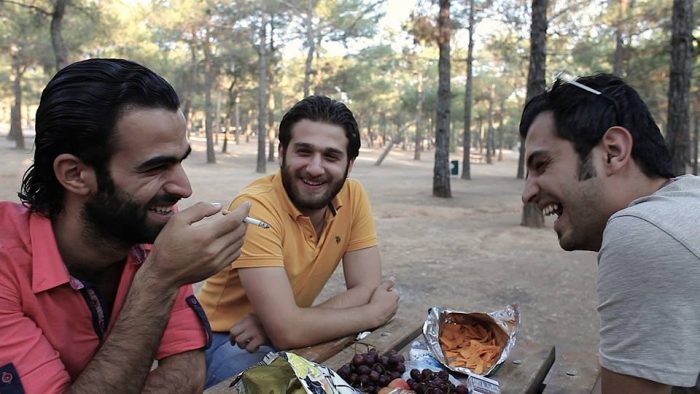
Aslıhan Ünaldı, Bordersongs, 2016 Videoinstallation / Video installation, 12’
Aslıhan Ünaldı’s multi-channel video is based on material of her unreleased film “Inbetween Nowhere”. “Bordersongs” is a rare intimate portrait of young Syrians. Theirs is the story of a new generation of Syrians caught unaware by a brutal civil war, robbed of their youth and forced into a state of constant transition, finding themselves in the middle of nowhere. It is a meditation on war and exile, questioning the established duality of perpetrator and victim and shows the human search for meaning, hope and love in exile.
Aslıhan Ünaldıs multi-channel Video basiert auf Material ihres noch unveröffentlichten Filmes „Inbetween Nowhere”. „Bordersongs“ ist ein rares und intimes Portrait von jungen, syrischen Menschen. Ihre Geschichten stehen für eine ganze Generation, die ihre Jugend und Unschuld im brutalen Bürgerkrieg verloren hat und sich nun, geistig wie körperlich, im Niemandsland befindet. Gleichzeitig versucht das Video die tradierten Dualitäten von Opfer und Täter, Schuld und Sühne in Frage zu stellen und zeigt die Suche nach Sinn, der Hoffnung und der Liebe im Exil.
Aslıhan Ünaldı is a filmmaker based in Brooklyn. Her award winning short film “Razan” premiered at the Rotterdam Film Festival in 2006 and went on to screen at dozens of festivals worldwide. Aslıhan holds a BA in Art (Photography) and International Studies from Yale University and an MFA in Film from New York University’s Tisch School of Arts, where she was the recipient of multiple scholarships and grants. In 2013 she was named a “Young Society Leader” by the American Turkish Society, and in 2016 she was selected as a “Film Independent Fellow”.
Aslıhan lebt als Filmemacherin in Brooklyn. Ihr preisgekrönter Kurzfilm „Razan“ wurde 2006 beim Rotterdam Film Festival uraufgeführt und bei Dutzenden internationalen Filmfestivals gezeigt. Aslıhan erwarb einen BA in Kunst (Fotografie) und internationalen Studien an der Yale University, sie erhielt einen MFA für Film an der Tisch School of Arts der New York University und gewann zahlreiche Stipendien und Preise. Im Jahr 2013 erhielt sie den Titel „Young Society Leader“ der Amerikanisch-Türkischen Gesellschaft, 2016 wurde sie als „Film Independent Fellow“ gewählt.
WHEN HOME WON’T LET YOU STAY
04/05 – 25/05 2016
Ausstellungszentrum / Exhibition Centre Heiligenkreuzer Hof,
Refektorium & Sala Terrena
Schönlaterngasse 5, 1010 Vienna
Begrüßung / Welcoming speech:
Gerald Bast
Kuratorin / Curator:
Işın Önol
Kuratorische Assistentin / Curatorial Assistant:
Carolina Nöbauer
Teilnehmende Künstlerinnen und Künstler / Participating artists:
2+1 (Selda Asal & Özgür Erkök Moroder) | Fatih Aydoğdu | Bernhard Cella | Canan Dağdelen | Omar Imam | Ebru Kurbak | Lorie Novak | Erkan Özgen | Mario Rizzi | Pınar Öğrenci | Hansel Sato | Cengiz Tekin | Aslıhan Ünaldı
Lecture Performance:
Mirwais Wakil
(in Zusammenarbeit mit / in collaboration with Melih Meriç)
Abteilung für Informations- und Veranstaltungsmanagement / Department of Information- and Eventmanagement:
Anja Seipenbusch-Hufschmied
Christian Schneider
Benedikt Fritz
Thomas Mitterböck
Zorislav Bosnjak
Jasmin Vogl
Elisabeth Falkensteiner
Presse / Press:
Andrea Danmayr
Mit besonderem Dank an / with special thanks to:
Barbara Putz-Plecko
Maria Zoe-Grausam
Berivan Aslan
Yaprak Yildiz
Marietta Böning
Leo Findeisen
Nita Tandon
Ahmed Shqaqi
Mehmet Matus
Melih Meriç
Ziya Azazi
Meric Fıratlı
Farshido Larimian
Saleh Rozati
Mit freundlicher Unterstützung von / with kind support of:
Flüchtlingsunterkunft Vordere Zollamsstraße
Tanzquartier Wien
AFAC/Magnum Foundation, New York
Matus art
RAHMENPROGRAMM / SIDE EVENTS
8 Mai 2016, 17 Uhr / 8th May 2016, 5 pm
Filmscreening: Aslıhan Ünaldı
Preview von Aslıhan Ünaldıs unveröffentlichem Dokumentarfilm „Inbetween Nowhere (work in progress)” und Q&A mit der Filmemacherin.
Preview of Aslıhan Ünaldı’s unreleased documentary “Inbetween Nowhere (work in progress)“ and Q&A with the filmmaker.
Ort / Venue: Schikaneder, Margaretenstraße 22-24, 1040 Wien
9 Mai 2016, 15:30 Uhr / 9th May, 3.30 pm
Artist Talk: Omar Imam
Exhibition Centre Heiligenkreuzer Hof
Schönlaterngasse 5, 1010 Wien
Ort / Venue: Ausstellungszentrum Heiligenkreuzer Hof, Refektorium
Schönlaterngasse 5, 1010 Wien
12 Mai 2016, 15:30 Uhr / 12th May, 3.30 pm
Kuratorenführung / Curatorial Tour: Isin Önol
Ort / Venue: Exhibition Centre Heiligenkreuzer Hof, Refektorium & Sala Terrena
Schönlaterngasse 5, 1010 Wien
17 Mai 2016, 18:00 Uhr / 17th May, 6 pm
Artist Talk: Bernhard Cella
Ort / Venue: Ausstellungszentrum Heiligenkreuzer Hof
Schönlaterngasse 5, 1010 Wien
20 Mai 2016, 15:30 Uhr / 20th May, 3.30 pm
Kuratorenführung / Curatorial Tour: Isin Önol
Ort / Venue: Exhibition Centre Heiligenkreuzer Hof, Refektorium & Sala Terrena
Schönlaterngasse 5, 1010 Wien
25 Mai 2016, 20:00 Uhr / 25 May, 8 pm
Filmscreening & Artist Talk: Mario Rizzi
Ort / Venue: Blickle Kino, 21er Haus
Arsenalstraße 1, 1030 Wien
(Zeit und Ort werden noch bestätigt werden)
Alle Veranstaltungen und Präsentationen werden in englischer Sprache abgehalten.
All the events and the presentations will be held in English.
when home won’t let you stay *
Während sich das 21. Jahrhundert entfaltet, verliert der Nationalismus rasch an Boden. Immer mehr Menschen glauben, dass die gesamte Menschheit die legitime Quelle politischer Autorität ist, und nicht die Angehörigen einer bestimmten Nation, und dass der Schutz der Menschenrechte und das
Sichern der Interessen der ganzen menschlichen Spezies das Leuchtfeuer der Politik sein sollte.**
Eines Tages bricht in einer bestimmten Region Gewalt aus, aus Gründen, die nur schwer zu fassen sind. Sie mögen mit religiöser Propaganda zu tun haben, mit ungebremstem Kapitalismus, Ressourcenknappheit, blutrünstigen Kriegsprofiteuren, Ungerechtigkeit bei der Verteilung von Land, mit ausländischen Mächten, oder einer traumatischen Vergangenheit. Menschen scheinen mehr als genug Gründe finden zu können, die ausreichen um einander abzuschlachten. Und wir als Beobachter sagen: das ist unmenschlich. Und das ist es tatsächlich, obwohl diese Art von Zusammenbruch der Zivilisation von Menschen wieder und wieder durchlebt wird.
Nun beginnt eine Million verzweifelter Reisen. Tausende Menschen lassen ihr Zuhause zurück, brechen auf, nehmen die Strapazen des Weges auf sich und beginnen eine andere Art von Kampf. Sie gehen, laufen, springen über Zäune, bleiben zu lange hungrig, schleppen das Gewicht ihrer Kinder, die notwendigsten Gegenstände und wenige persönliche Erinnerungsstücke. All das führen sie mit sich, und sie führen ihre Reise fort: Das erfordert viel Mut, Stärke und Verzweiflung. Dennoch tun es diese Menschen; Menschen tun dergleichen, wenn es um ihr Überleben geht. Sind sie schon in einem sicheren Land angekommen? Keinesfalls; noch hat ihre Reise gerade erst begonnen. Unaussprechlicher Missbrauch findet unterwegs statt, immer wieder und durch die unterschiedlichsten Täter. Es gibt keine andere Hoffnung als immer weiter vor dem Unmenschlichen wegzulaufen, vor dem rastlosen Bösen, das die Verletzlichen mit einer zynischen Leere umgibt.
Es ist nicht so, als würden die Zuschauer nicht reagieren: Sie organisieren sich spontan, sie helfen, die Reisen zu ermöglichen: Oft verlangen sie viel Geld, überfüllen die Rettungsboote und entführen die Menschen ins Unbekannte. Jene, die das Potential des neuen Marktes schnell verstehen, lernen gefälschte Schwimmwesten – die bald „Todeswesten“ genannt werden – herzustellen und verursachen das Ertrinken Hunderter. Die Toten haben keine Ausweispapiere und somit auch keinen Beweis dafür, dass sie jemals gelebt haben. Sie hatten keine Identität, die irgendjemand respektiert hätte. Es ist eine Wildnis, ein grenzenloser Schauplatz für alle Arten des Verbrechens.
Manche schaffen es bis ans andere Ufer, aber Tausenden gelingt es nicht. Wenn man mit denen spricht, die auf der anderen Seite angekommen sind, hört man oft, dass es ihnen nicht beim ersten Versuch gelungen ist. Es war nicht das erste Boot, das sie bestiegen haben, das sie ans andere Ufer gebracht hat, oder auch in die Tiefen des Meeres. Es braucht viele Versuche, wieder und wieder, bis sie an irgendeiner sicheren Küste an Land gehen können. Kinder verschwinden, werden entführt, gelangen auf dunklen Wegen zu einem namenlosen Schicksal, das von den geschickten Agenten des Menschenhandels bestimmt wird. Grenzenlose Gewalt, strategischer Zynismus, Profitgier, politische Spiele, institutionelle Inkompetenz, moralischer Mut ebenso wie Feindseligkeit, Chaos, erzwungene Sicherheit, gelähmte wie um sich schlagende Staaten. Emergierende Solidarität und drohender Zusammenbruch der öffentlichen Ordnung; Gesten der Freundschaft, und ein beängstigendes Gefühl der Einsamkeit und des Ausgeliefertseins – all diese Konsequenzen menschlichen Handelns prallen auf die Gehenden, wie eine endlose Reihe von Schlägen.
Menschen sind unübertrefflich darin, sich zu organisieren, im Bösen wie im Guten: Manche fühlen sich tatsächlich zutiefst verantwortlich, sie eilen an die Küsten und helfen jenen, die es an Land geschafft haben, oder versuchen Unterkünfte, Nahrung, Kleidung, Wärme und anderes unmittelbar Notwendiges bereitzustellen. Die Reise zeigt von ihrem Anfang bis an ihr Ende die vielen widersprüchlichen Seiten des Mensch-Seins und des Menschlich-Seins: zahllose Formen von Feindseligkeit und Grausamkeit ebenso wie Empathie, Großzügigkeit und Unterstützung in enormem Ausmaß. Die Reise verlangt nicht nur viel Mut, sondern auch viel Hoffnung, und großes Vertrauen in die Menschheit: dass irgendwo ein Land ist, in dem sie sicher und willkommen sind, und wo ein neues Leben beginnen kann, wenigstens so lange, bis eine Rückkehr möglich ist.
Aber in diesem Land, in dieser anderen Welt, nennen jene, die niemals die vorangegangene Katastrophe erleben mussten (oder die rasch jene Katastrophen, die in ihrer jüngeren Vergangenheit auf ihnen lasteten, vergessen haben) die Ankunft der Flüchtlinge eine „Krise“. Die Einwohner des sicheren Landes fühlen sich bedroht: ihre Identitäten würden zerstört werden, die Kosten der Gastfreundschaft seien zu hoch, ihre gut ausgebauten Systeme würden zusammenbrechen, ihre Menschlichkeit unter dem Unwissen der Neuankömmlinge leiden – ein Paradoxon.
Wäre die Solidarität stärker gewesen, dann gäbe es den Alptraum der Krise nicht, und wir könnten stattdessen jene ermutigende und belebende Erfahrung machen, dass wir gemeinsam unser Schicksal bestimmen können. Wir haben uns selbst dieser kollektiven Emotionen beraubt als wir Ordnung über Empathie, Identitätskontrolle über Begegnung und taktische Staatsräson über strategische Menschlichkeit gestellt haben. Tatsächlich haben die Einwohner der sicheren und reichen Länder nicht nur im Lauf dieser neuesten Krise dabei versagt, jene in eine Gelegenheit zu verwandeln und sie zu verwenden, um die Struktur und Atmosphäre des Zusammenlebens neu zu formen und aufzubauen. Nachdem die Neuankömmlinge die äußeren Perimeter des sicheren und reichen Gebiets durchquert haben, werden sie viele Formen institutionalisierter Ungerechtigkeit erleben müssen, soziale Unbeweglichkeit und individuelle Isolation, die über Generationen erhalten und gefestigt wurden. Es wird deutlich werden, in welchem ungeheuren Ausmaß auch die reichen Gesellschaften stratifiziert, undurchdringlich und teilnahmslos sind, und dass sie in Form von Pyramiden wachsender Ausbeutung organisiert sind.
Auf der 3500 Kilometer langen Reise von einem nun unbewohnten Haus in Aleppo nach Wien muss ein syrischer Flüchtling den Stand der Humanität und Menschlichkeit in unserer Zeit kennenlernen und erdulden. Beim Versuch, die Welt durch die Augen von jemandem zu sehen, der aufbricht um Zuflucht zu suchen, entfaltet sich ein entlarvendes Bild vernichtender menschlicher Erlebnisse: Das Bild einer Katastrophe, die aus einer endlosen Kette von Gräueltaten und Vernachlässigung hervorgeht; jedoch auch Erfahrungen von Unterstützung und Mitgefühl. Die Ausstellung „when home won’t let you stay“ setzt ihren Schwerpunkt auf diese erstaunlich verschiedenen Schattierungen von Menschlichkeit und untersucht die Bedeutung von Humanität im frühen 21. Jahrhundert. Sie hinterfragt, was es heute heißt, Mensch zu sein, im Vergleich zu den Idealen der Menschlichkeit und der Menschenrechte. Die Ausstellung wirft Fragen über die Möglichkeiten sozio-ökonomischer und politischer Entwicklungen hin zu einem bewussteren Zusammenleben auf, nicht nur als temporäre Lösung dieser unmittelbaren Katastrophe – der sogenannten Flüchtlingskrise – sondern auch in Gegenüberstellung mit unseren individuellen und gemeinschaftlichen Herangehensweisen an das Mensch-Sein.
Die Ausstellung – deren Titel dem Gedicht „Home“ von Warsan Shire entlehnt ist – versucht, die Reisen der Vertriebenen nachzuzeichnen, zwischen ihrem verlorenen und einem neuen Zuhause, das erst noch erbaut werden muss.
Text von Işın Önol & Tobias Nöbauer
Übersetzung (Englisch-Deutsch): Agnes Blaha
Lektorieren: Roswitha Janowski-Fritsch, Carolina Nöbauer
* Warsan Shire, Home, Gedicht, 2015
Eine frühere Fassung des Gedichts erschien unter dem Titel “Conversations about Home (At the Deportation Centre)”, in Teaching my mother how to give birth, Flipped Eye, London, 2011
** Yuval Noah Harari, Sapiens: A Brief History of Humankind, p.231, Vintage Books, London, 2011

